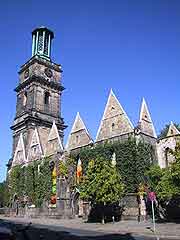Hanover History Facts and Timeline
(Hanover, Lower Saxony, Germany)

Hanover's name is thought to derive from the word 'honovere', which means 'high bank'. Whether or not this is true is still subject to debate. Certainly, a settlement did grow up here next of the River Leine. Its earliest history is as a small village frequented by numerous fishermen.
It wasn't until the Middle Ages, however, that Hanover grew as a community of tradesmen and craftsmen. From the 14th century, a defensive wall started to be built around the town, punctuated by several gates. A number of prominent churches were also built during this period.
From the 17th Century to the 19th Century
It was in the 17th century that the town acquired its connections with royalty, when in 1636, the Duke of Calenberg decided to move his residence here. Later, it became known as the Duchy of Hanover.
In 1708, history remembers how the city rose in status, becoming the Electorate of Brunswick-Luneberg. Three British monarchs were subsequently to become electoral princes of Hanover - King George I was the first. Even though they were electors of Hanover, they rarely chose to visit the city.
In July 1803, Napoleon's French soldiers, some 30,000 in number, occupied the city. After the Congress of Vienna of 1815, the city changed from being an electorate to part of the unified Kingdom of Hanover. As its capital city, Hanover expanded considerably during this period.
In 1837, the links between Britain and Hanover finally ended. The monarchy was restructured when King William IV died and Queen Victoria was appointed as his heir. Control passed to Ernest Augustus, William's brother. It remained as a kingdom until 1866. In that year, it became part of Prussia - something that didn't sit well with the city's inhabitants.
Such political change did, however, have a significant effect on Hanover's success as a trading city. The late 19th century was a period of growth here and its population rose, particularly when new innovations, such as the railway, arrived in the city.
In 1891, Heinrich Tramm was appointed as the city's urban director. He shaped Hanover in his own style. Indeed, the period between the start of the 20th century and the outbreak of World War One is widely known as the 'Tramm Era'.
History in the 20th Century
In the 1930s, the Jewish population was subject to Hitler's policies. In November 1938, the city's synagogue was burnt down. During World War Two, Hanover was severely damaged by Allied bombing raids. There were many targets in the city, including an oil refinery, metal works and railway junctions. Allied forces reached the city in April 1945 and Hanover came under the control of the British. Finally, in 1946, the city became part of a new state known as Lower Saxony.
Hanover has always played a central role in Germany's history. In recent years, it has taken on a new role in the eyes of the world, becoming increasingly popular as a tourist destination.
 Hanover's name is thought to derive from the word 'honovere', which means 'high bank'. Whether or not this is true is still subject to debate. Certainly, a settlement did grow up here next of the River Leine. Its earliest history is as a small village frequented by numerous fishermen.
Hanover's name is thought to derive from the word 'honovere', which means 'high bank'. Whether or not this is true is still subject to debate. Certainly, a settlement did grow up here next of the River Leine. Its earliest history is as a small village frequented by numerous fishermen.